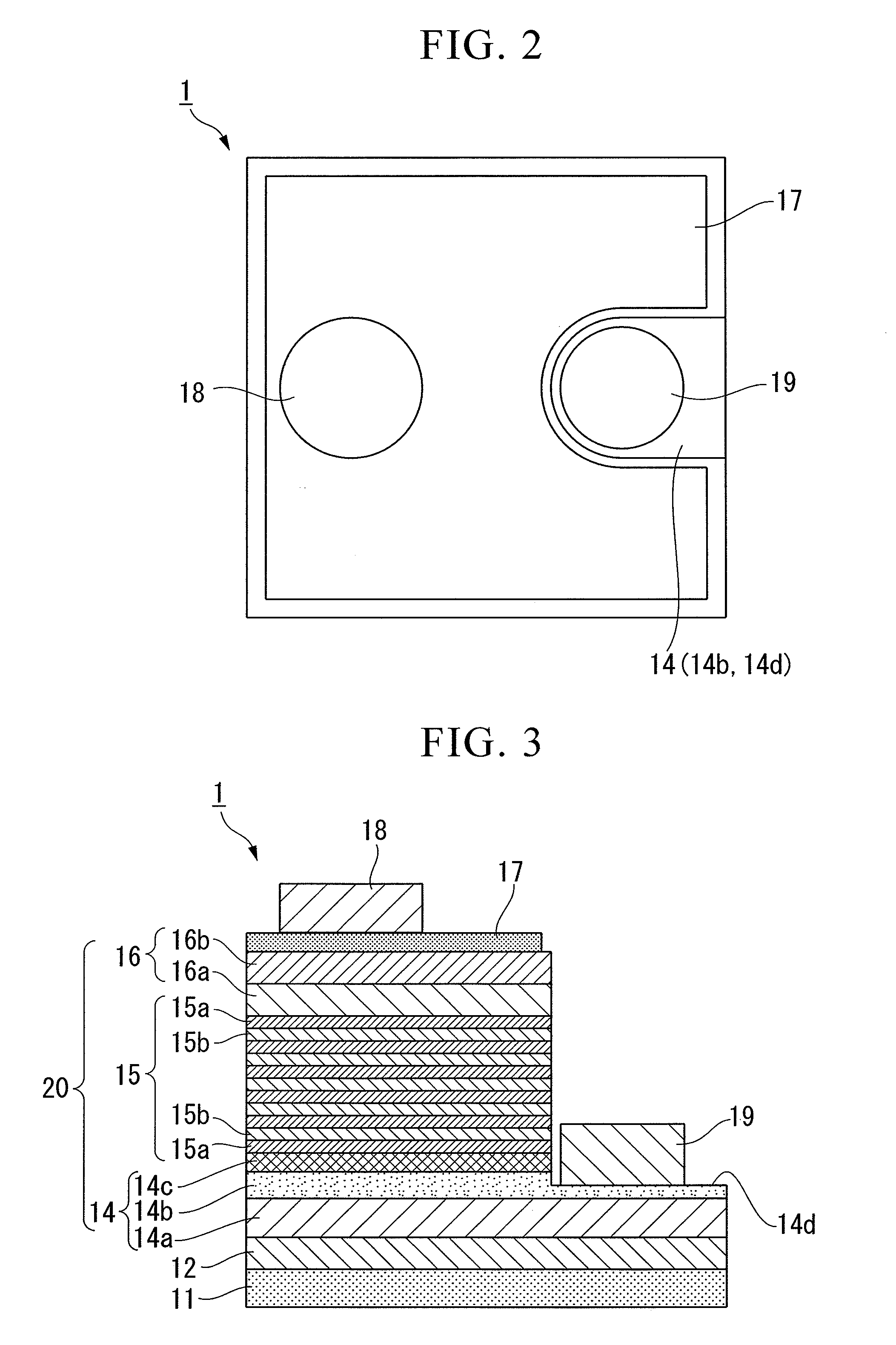Group iii nitride semiconductor light-emitting device, method for manufacturing the same, and lamp
- Summary
- Abstract
- Description
- Claims
- Application Information
AI Technical Summary
Benefits of technology
Problems solved by technology
Method used
Image
Examples
example 1
[0179]FIG. 1 shows a cross-sectional schematic view of the laminated semiconductor of the Group III nitride compound semiconductor light-emitting device manufactured in the present experimental example.
[0180]In the present example, on the c-plane of the substrate 11 composed of sapphire, there was formed, a single crystal layer composed of AlN that serves as the buffer layer 12, and on this, there was formed, by means of reactive sputtering, a layer composed of GaN (Group III nitride semiconductor) that serves as the base layer 14a.
“Formation of Buffer Layer”
[0181]First, a substrate formed of a 2-inch diameter (0001) c-plane sapphire that had been polished to a mirror surface was cleaned using a hydrofluoric acid and organic solvent, and then was placed inside a chamber. At this time, as the sputtering apparatus, as with the sputtering apparatus 40 illustrated in the example in FIG. 5, there was used an apparatus that has a high frequency type power supply and that has a mechanism ...
example 2
[0210]Using the same procedure as Example 1 above with the exception of using conditions where the crystal structure of a buffer layer to be formed on the substrate becomes a polycrystalline structure formed of a columnar crystal aggregate, the buffer layer was laminated on the substrate, an undoped GaN layer (a base layer) was laminated thereon, and respective layers composed of Group III nitride semiconductors were further formed, thereby producing a light-emitting device shown in FIG. 2 and FIG. 3.
[0211]When the X-ray rocking curve (XRC) of the buffer layer formed on the substrate was measured using the same method as Example 1, the XRC full width at half maximum was 12 arcsec. Moreover, the composition of the buffer layer was measured using an X-ray photoelectron spectroscopy apparatus (XPS), and as with Example 1, the measurement result confirmed that the oxygen concentration was 1 atomic percent or lower.
[0212]Using the same method as Example 1, a GaN layer was formed on the b...
experimental example
[0222]Hereunder, there is described, with reference to the respective graphs in FIG. 7A and FIG. 7B, an experimental example for substantiating the present invention. FIG. 7A is a graph showing a relationship between the number of dummy discharges and oxygen concentration in the buffer layer, and FIG. 7B is a graph showing a relationship between ultimate vacuum within the chamber and oxygen concentration within the buffer layer.
[0223]In the present experimental example, after conducting a pretreatment on the substrate, dummy discharging was performed the number of times shown in FIG. 7A when removing impurities by suctioning inside the chamber using a vacuum pump, and the ultimate vacuum was set to conditions shown in FIG. 7B (No. 1=2.0×10−5 Pa, No. 2=3.1×10−5 Pa, No. 3=5.1×10−5 Pa, No. 4=1.5×10−4 Pa). With the exception of this, the same method as Example 1 was used to manufacture respective samples No. 1 to 4 comprising a buffer layer formed on the substrate.
[0224]When the X-ray r...
PUM
 Login to View More
Login to View More Abstract
Description
Claims
Application Information
 Login to View More
Login to View More - R&D
- Intellectual Property
- Life Sciences
- Materials
- Tech Scout
- Unparalleled Data Quality
- Higher Quality Content
- 60% Fewer Hallucinations
Browse by: Latest US Patents, China's latest patents, Technical Efficacy Thesaurus, Application Domain, Technology Topic, Popular Technical Reports.
© 2025 PatSnap. All rights reserved.Legal|Privacy policy|Modern Slavery Act Transparency Statement|Sitemap|About US| Contact US: help@patsnap.com



